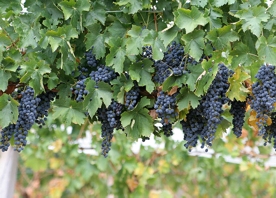| Perennial / Desiduous Trees / Delicious red(dark) Globe GRAPE Fruit Vine |
|
|
|
|
| |
|
Plant name - Grape (Greek variety)
|

|
|
 |
|
 |
| Common name - Grape
|
| Plant type - Desiduous |
| Vegetation type -
Perennial |
| Growth rate - Fast |
| Leaf / Flower color
- Green / green |
| Other names - Grape
|
| |
| Description : |
A grape is a fruiting berry of the deciduous woody vines of the botanical genus Vitis. Grapes can be eaten raw or they can be used for making wine, jam, juice, jelly, grape seed extract, raisins, vinegar, and grape seed oil. Grapes are a non-climacteric type of fruit, generally occurring in clusters.
The cultivation of the domesticated grape began 6,000–8,000 years ago in the Near East. The earliest archeological evidence for a dominant position of wine-making in human culture dates from 8,000 years ago in Georgia.
Yeast, one of the earliest domesticated microorganisms, occurs naturally on the skins of grapes, leading to the innovation of alcoholic drinks such as wine. The earliest known production occurred around 8,000 years ago on the territory of Georgia. During an extensive gene-mapping project, archaeologists analyzed the heritage of more than 110 modern grape cultivars, and narrowed their origin to a region in Georgia, where wine residues were also discovered on the inner surfaces of 8,000-year-old ceramic storage jars.
The oldest winery was found in Armenia, dating to around 4000 BC. By the 9th century AD the city of Shiraz was known to produce some of the finest wines in the Middle East. Thus it has been proposed that Syrah red wine is named after Shiraz, a city in Persia where the grape was used to make Shirazi wine. Ancient Egyptian hieroglyphics record the cultivation of purple grapes, and history attests to the ancient Greeks, Phoenicians and Romans growing purple grapes for both eating and wine production. The growing of grapes would later spread to other regions in Europe, as well as North Africa, and eventually in North America.
In North America, native grapes belonging to various species of the Vitis genus proliferate in the wild across the continent, and were a part of the diet of many Native Americans, but were considered by European colonists to be unsuitable for wine. Vitis vinifera cultivars were imported for that purpose.
.
|
| |
| Growing Instructions : |
* Plant the seeds in a small pot just under the top layer of soil. Place the pot inside a plastic bag. Alternatively, the seeds can be placed directly inside the bag, but this requires transferring them to a pot later.
* Refrigerate the grape seeds for 30 to 90 days. Grape seeds require a period of cold at temperatures below 40 Fahrenheit degrees in order to end their dormancy. If you have a cold, dark area outdoors that is free of wind and rain, you can store your seeds outside during the winter. Do not allow your seeds to freeze.
* Remove the seeds from the refrigerator and allow them to warm inside your home. Keep the seeds inside the plastic bag used to store them in the refrigerator. Seeds should not be placed outdoors in direct sunlight, as too much heat and light will cause the seeds to die.
* Remove the seeds from the plastic bag once they begin to germinate, typically after 30 days of warmer temperatures. The seeds should be placed on a windowsill or in a sunny, dry location outdoors. The soil inside your pot should be kept moist, but be careful not to over water.
* Transplant your seedlings into separate pots once they have grown to be about 8 cm tall. Place the seedlings in a sheltered, shady area away from rain and wind for 10 to 14 days.
* Move your seedlings to a permanent location in direct sun. Plants should be spaced 96 inches apart.
|
| |
|
|
|
|
|
